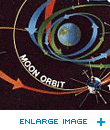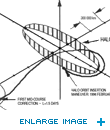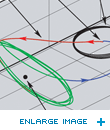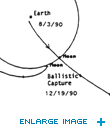Space Travel:
Mathematics Uncovers an Interplanetary Superhighway
Previous Mission Trajectories
Mission designs have a common problem: fuel. Fuel, or propellant, is a major factor limiting a spacecraft's journey. Fuel needs rise dramatically depending on how far apart the destinations are you want to visit, the length of time you want to stay there (in orbit), and the number of instruments you carry on board. One way around this is to design space mission trajectories which use the complex interplay of gravitational forces from multiple bodies. This leads to trajectories which either can't be designed using "straightforward" methods or are very fuel efficient compared to a straightforward approach. Some examples are listed below.
International Sun-Earth Explorer/International Cometary Explorer
 In
1972, the International Sun-Earth Explorer (ISEE) Program was estabilished,
a joint project of NASA and the European Space Agency (ESA) which was to involve
three spacecraft. One of these, ISEE-3,
was launched into a halo orbit around the Sun-Earth L1 point in 1978, allowing
it to collect data on solar wind conditions upstream from Earth. ISEE-3 accomplished
many scientific goals. After the primary mission was completed, ISEE-3 went
on to accomplish other goals, including a flight through the geomagnetic tail
and a comet flyby, by utilizing the interesting dynamics in the Sun-Earth-Moon
system. The mission was subsequently renamed the International Cometary Explorer
(ICE).
In
1972, the International Sun-Earth Explorer (ISEE) Program was estabilished,
a joint project of NASA and the European Space Agency (ESA) which was to involve
three spacecraft. One of these, ISEE-3,
was launched into a halo orbit around the Sun-Earth L1 point in 1978, allowing
it to collect data on solar wind conditions upstream from Earth. ISEE-3 accomplished
many scientific goals. After the primary mission was completed, ISEE-3 went
on to accomplish other goals, including a flight through the geomagnetic tail
and a comet flyby, by utilizing the interesting dynamics in the Sun-Earth-Moon
system. The mission was subsequently renamed the International Cometary Explorer
(ICE).
Solar and Heliospheric Observatory
 In the mid-1980s, a team in Barcelona were the first to study the invariant manifolds of halo orbits and apply them to the design of a space mission, in particular the Solar and Heliospheric Observatory (SOHO) mission. SOHO is a mission designed to study the internal structure of the Sun, its extensive outer atmosphere and the origin of the solar wind, the stream of highly ionized gas that blows continuously outward through the solar system. It is a joint project of the European Space Agency (ESA) and NASA.
In the mid-1980s, a team in Barcelona were the first to study the invariant manifolds of halo orbits and apply them to the design of a space mission, in particular the Solar and Heliospheric Observatory (SOHO) mission. SOHO is a mission designed to study the internal structure of the Sun, its extensive outer atmosphere and the origin of the solar wind, the stream of highly ionized gas that blows continuously outward through the solar system. It is a joint project of the European Space Agency (ESA) and NASA.
Genesis Discovery Mission
 The Genesis spacecraft collected solar wind samples from a halo orbit about the Sun-Earth L1 point for two years, sending them back to Earth via a sample-return capsule which returned to Earth in September 2004 for analysis and examination. The solar wind was imbedded in a set of ultra-pure material collectors the size of bicycle tires that were deployed throughout the collection phase of the mission. The sample is the only extraterrestrial material brought back to Earth from deep space since the last of the Apollo landings in 1972, and the first to be collected from beyond the Moon's orbit. Ongoing analysis of the samples collected by the mission will contribute to our understanding of the origins of the solar system.
The Genesis spacecraft collected solar wind samples from a halo orbit about the Sun-Earth L1 point for two years, sending them back to Earth via a sample-return capsule which returned to Earth in September 2004 for analysis and examination. The solar wind was imbedded in a set of ultra-pure material collectors the size of bicycle tires that were deployed throughout the collection phase of the mission. The sample is the only extraterrestrial material brought back to Earth from deep space since the last of the Apollo landings in 1972, and the first to be collected from beyond the Moon's orbit. Ongoing analysis of the samples collected by the mission will contribute to our understanding of the origins of the solar system.
Hiten (MUSES-A)
 The first example of a low-fuel path to the moon was the rescue of a malfunctioned Japanese space mission to the Moon by Belbruno and Miller of NASA's Jet Propulsion Laboratory in June 1990. The mission originally had two spacecraft, MUSES-A and MUSES-B; B was to go into orbit around the Moon, with A remaining in Earth orbit as a communications relay. But B failed and A did not have sufficient fuel to make the journey. However, by utilizing a trajectory concept originally discovered by Belbruno in 1986, which is more energy-efficient than the one planned for B, MUSES-A (renamed Hiten) left Earth orbit in April, 1991 and reached the Moon that October. As a result, Japan became the third nation to send a spacecraft to the Moon. After a series of scientific experiments, Hiten was purposely crashed into the Moon in April, 1993.
The first example of a low-fuel path to the moon was the rescue of a malfunctioned Japanese space mission to the Moon by Belbruno and Miller of NASA's Jet Propulsion Laboratory in June 1990. The mission originally had two spacecraft, MUSES-A and MUSES-B; B was to go into orbit around the Moon, with A remaining in Earth orbit as a communications relay. But B failed and A did not have sufficient fuel to make the journey. However, by utilizing a trajectory concept originally discovered by Belbruno in 1986, which is more energy-efficient than the one planned for B, MUSES-A (renamed Hiten) left Earth orbit in April, 1991 and reached the Moon that October. As a result, Japan became the third nation to send a spacecraft to the Moon. After a series of scientific experiments, Hiten was purposely crashed into the Moon in April, 1993.



